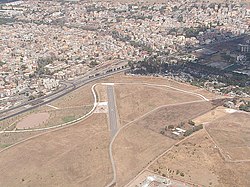Rome Centocelle military airfield
| Rome Centocelle military airfield “Francesco Baracca” |
|
|---|---|

|
|
| Characteristics | |
| ICAO code | LIRC |
| Coordinates | |
| Height above MSL | 48 m (157 ft ) |
| Transport links | |
| Distance from the city center | 5 km southeast of Rome |
| Street | Via di Centocelle, Via Casilina , Via Tuscolana, A90 GRA |
| train | Metro stations: Numidio Quadrato, Parco di Centocelle |
| Local transport | Metropolitana di Roma , lines A, C |
| Basic data | |
| opening | April 15, 1909 |
| operator | Aeronautica Militare |
| Start-and runway | |
| 9/27 | Asphalt (closed) |
The Rome-Centocelle military airfield is located on Via Latina in the southeast of the Italian capital Rome . It is the oldest airfield in Italy . Today it serves as the location of various military command authorities and as a small heliport .
history
When the American aviation pioneer Wilbur Wright came to Rome with his flyer in April 1909, a meadow was being prepared as an airfield on Via Casilina in what is now Centocelle . From April 15 to April 26, 1909, Wright carried out a number of flights here at the invitation of the recently founded Roman aerospace club, which also served to train prospective Italian pilots. Among them was the first Italian military pilot Mario Calderara , who then worked as an instructor in Centocelle . The Centocelle airfield was expanded by 1910 and the first flight school was set up, which trained both military pilots of the new air force and civilian pilots. In the spring of 1911, the new flight schools in Cascina Malpensa and Aviano replaced the school in Centocelle. The Centocelle airfield was then mainly used for air transport purposes until the Second World War. On May 17, 1919, a British Handley Page had an accident in Centocelle during a stopover on the way from London to Cairo . Lawrence of Arabia was among the survivors . On February 14, 1920 Arturo Ferrarin took off from Centocelle on his record flight to Japan . On November 4, 1923, the Italian Air Force ( Regia Aeronautica ) , founded a few months earlier, received its troop flag in Centocelle . During the Second World War, Centocelle was the target of several Allied air raids, which largely destroyed the airfield. After the war, the urban development of Rome made expansion impossible. Until 1949, the airfield was the location of an air transport squadron , then until 1959 of parts of the aviation staff, which finally moved to Rome-Ciampino Airport . In 1960 fixed-wing aircraft operations in Centocelle were completely discontinued. On the southern part of the airfield, the runway of which was largely demolished, military offices of the Italian Air Force remained . The northern part was converted into a city park ( Parco di Centocelle ), other areas served as a new development area. In the city park, part of the runway with threshold 27 was left as a reminder of Centocelle's importance in aviation history. The airfield is considered the cradle of Italian aviation.
Infrastructure and use
The southern part of the airfield, located near Via Tuscolana , continues to be used for military purposes and is referred to as the "military airfield", although it is de facto only barracks with a small helipad in the east. The command and control command of the Italian armed forces ( COI ) and their special forces command ( COFS ) as well as offices of the Italian air force are located there today .
In 2016, the General Secretariat and the Armaments Department of the Ministry of Defense (Segretariato Generale della Difesa - Direzione Nazionale degli Armamenti) moved into a new building on the site of the former airfield. This means that essential parts of the ministry and the military leadership are now in Rome-Centocelle.